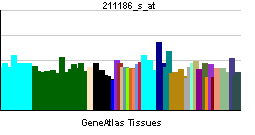AAK1
| AP2 associated kinase 1 | |||||||||
|---|---|---|---|---|---|---|---|---|---|
| Identifiers | |||||||||
| Symbols | AAK1 ; KIAA1048; MGC138170 | ||||||||
| External IDs | Template:MGI HomoloGene: 75032 | ||||||||
| |||||||||
| RNA expression pattern | |||||||||
 | |||||||||
 | |||||||||
| More reference expression data | |||||||||
| Orthologs | |||||||||
| Template:GNF Ortholog box | |||||||||
| Species | Human | Mouse | |||||||
| Entrez | n/a | n/a | |||||||
| Ensembl | n/a | n/a | |||||||
| UniProt | n/a | n/a | |||||||
| RefSeq (mRNA) | n/a | n/a | |||||||
| RefSeq (protein) | n/a | n/a | |||||||
| Location (UCSC) | n/a | n/a | |||||||
| PubMed search | n/a | n/a | |||||||
AP2 associated kinase 1, also known as AAK1, is a human gene.[1]
Adaptor-related protein complex 2 (AP-2 complexes) functions during receptor-mediated endocytosis to trigger clathrin assembly, interact with membrane-bound receptors, and recruit encodytic accessory factors. This gene encodes a member of the SNF1 subfamily of Ser/Thr protein kinases. The protein interacts with and phosphorylates a subunit of the AP-2 complex, which promotes binding of AP-2 to sorting signals found in membrane-bound receptors and subsequent receptor endocytosis. Its kinase activity is stimulated by clathrin. Alternatively spliced transcript variants have been described, but their biological validity has not been determined.[1]
References
Further reading
- Manning G, Whyte DB, Martinez R; et al. (2003). "The protein kinase complement of the human genome". Science. 298 (5600): 1912–34. doi:10.1126/science.1075762. PMID 12471243.
- Kikuno R, Nagase T, Ishikawa K; et al. (1999). "Prediction of the coding sequences of unidentified human genes. XIV. The complete sequences of 100 new cDNA clones from brain which code for large proteins in vitro". DNA Res. 6 (3): 197–205. PMID 10470851.
- Ricotta D, Conner SD, Schmid SL; et al. (2002). "Phosphorylation of the AP2 mu subunit by AAK1 mediates high affinity binding to membrane protein sorting signals". J. Cell Biol. 156 (5): 791–5. doi:10.1083/jcb.200111068. PMID 11877457.
- Conner SD, Schmid SL (2002). "Identification of an adaptor-associated kinase, AAK1, as a regulator of clathrin-mediated endocytosis". J. Cell Biol. 156 (5): 921–9. doi:10.1083/jcb.200108123. PMID 11877461.
- Strausberg RL, Feingold EA, Grouse LH; et al. (2003). "Generation and initial analysis of more than 15,000 full-length human and mouse cDNA sequences". Proc. Natl. Acad. Sci. U.S.A. 99 (26): 16899–903. doi:10.1073/pnas.242603899. PMID 12477932.
- Conner SD, Schmid SL (2003). "Differential requirements for AP-2 in clathrin-mediated endocytosis". J. Cell Biol. 162 (5): 773–9. doi:10.1083/jcb.200304069. PMID 12952931.
- Conner SD, Schröter T, Schmid SL (2004). "AAK1-mediated micro2 phosphorylation is stimulated by assembled clathrin". Traffic. 4 (12): 885–90. PMID 14617351.
- Ota T, Suzuki Y, Nishikawa T; et al. (2004). "Complete sequencing and characterization of 21,243 full-length human cDNAs". Nat. Genet. 36 (1): 40–5. doi:10.1038/ng1285. PMID 14702039.
- Mishra SK, Hawryluk MJ, Brett TJ; et al. (2004). "Dual engagement regulation of protein interactions with the AP-2 adaptor alpha appendage". J. Biol. Chem. 279 (44): 46191–203. doi:10.1074/jbc.M408095200. PMID 15292237.
- Beausoleil SA, Jedrychowski M, Schwartz D; et al. (2004). "Large-scale characterization of HeLa cell nuclear phosphoproteins". Proc. Natl. Acad. Sci. U.S.A. 101 (33): 12130–5. doi:10.1073/pnas.0404720101. PMID 15302935.
- Gerhard DS, Wagner L, Feingold EA; et al. (2004). "The status, quality, and expansion of the NIH full-length cDNA project: the Mammalian Gene Collection (MGC)". Genome Res. 14 (10B): 2121–7. doi:10.1101/gr.2596504. PMID 15489334.
- Hillier LW, Graves TA, Fulton RS; et al. (2005). "Generation and annotation of the DNA sequences of human chromosomes 2 and 4". Nature. 434 (7034): 724–31. doi:10.1038/nature03466. PMID 15815621.
- Kim JE, Tannenbaum SR, White FM (2005). "Global phosphoproteome of HT-29 human colon adenocarcinoma cells". J. Proteome Res. 4 (4): 1339–46. doi:10.1021/pr050048h. PMID 16083285.
- Kimura K, Wakamatsu A, Suzuki Y; et al. (2006). "Diversification of transcriptional modulation: large-scale identification and characterization of putative alternative promoters of human genes". Genome Res. 16 (1): 55–65. doi:10.1101/gr.4039406. PMID 16344560.
- Collawn JF (2006). "Unlocking the mysteries of Na+-K+-ATPase endocytosis: phosphorylation is the key". Am. J. Respir. Cell Mol. Biol. 35 (1): 1–2. doi:10.1165/rcmb.f317. PMID 16782842.
- Schmid EM, Ford MG, Burtey A; et al. (2007). "Role of the AP2 beta-appendage hub in recruiting partners for clathrin-coated vesicle assembly". PLoS Biol. 4 (9): e262. doi:10.1371/journal.pbio.0040262. PMID 16903783.
- Beausoleil SA, Villén J, Gerber SA; et al. (2006). "A probability-based approach for high-throughput protein phosphorylation analysis and site localization". Nat. Biotechnol. 24 (10): 1285–92. doi:10.1038/nbt1240. PMID 16964243.
- Takahashi T, Furuchi T, Naganuma A (2007). "Endocytic Ark/Prk kinases play a critical role in adriamycin resistance in both yeast and mammalian cells". Cancer Res. 66 (24): 11932–7. doi:10.1158/0008-5472.CAN-06-3220. PMID 17178891.
- Henderson DM, Conner SD (2007). "A novel AAK1 splice variant functions at multiple steps of the endocytic pathway". Mol. Biol. Cell. 18 (7): 2698–706. doi:10.1091/mbc.E06-09-0831. PMID 17494869.
| This protein-related article is a stub. You can help Wikipedia by expanding it. |